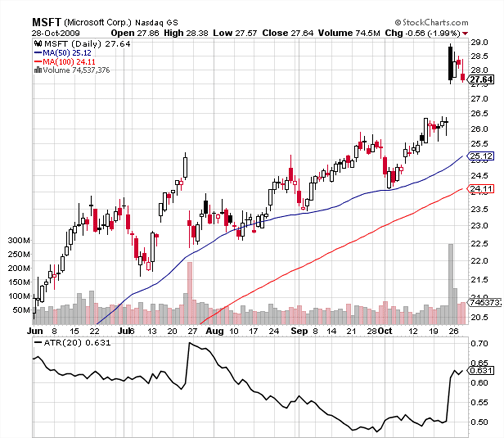|
Should I Use a Stop Loss Order?SPONSOR: Yes. You should absolutely use stop loss orders - especially after you place any new trade. This the the time when the emotional aspect of selling is most unstable because at the beginning of any trade, most people don’t want to be wrong. With a stop loss in place it gives a layer of protection for your capital and the chance for a “do over” - hopefully, in a better stock position.
You made a decision to buy the stock based on your stock set-up strategy and it can get tough to make a clear decision if the market or individual stock goes against you. There’s just no reason to put the weight of that decision on your shoulders when a stock is falling. And, you just don’t want to be in a position, day-after-day staring at the loss, when you could be out of that stock and gaining in another. Let’s try an exercise. Think about how you would feel if a stock you owned was down 20%. Now think about that stock going down 40%. Do you realize that if you owned a stock that went down 40%, it would have to gain 80% to bring the price back up to the price you paid for it? Oh, and don’t forget the time wasted spent waiting for it to come back even if it did return to the purchase price. Another time to use a stop loss is if you’re not able to watch stock activity during the day whether you're on vacation or busy for some other reason. If you leave a position unprotected, it leaves you wide open for any kind of loss. If you’ve got that stop loss order, you’re in control of your money even when you're away. Ultimately, that’s what a stop loss does for you – it keeps you in control of your money.
Always place the stop immediately after purchasing a stock, because this way you don’t have to worry about it, you haven’t forgotten about it and you’re covered.
To preserve capital so that you can trade another day, the general rule is to be willing to risk or lose no more than 1-2% of your total stock market portfolio on any one trade. If you’re more conservative, 1% might be the right figure. As an example, a $10,000 portfolio with a 1% risk tolerance would mean that on any one trade you are willing to lose $100, but no more. If you used $1,000 of your portfolio for one position and were willing to let the stock price to go down $100, that would be 10% of that position from your purchase price. This is your line in the sand. If a stock is going to go up - great. If it's going to go down - get out! This strategy gives you a good layer of protection. Consider that if you had five losses in a row, that would total $500, and that’s only 5% of your total stock market portfolio. The good news is you would still have $9,500 to trade another day. You could place a set percentage or dollar amount stop loss across the board for all stock purchases. Some stock trading systems use a uniform stop of 7-8% and any limit amount can be chosen, but stocks have different price volatilities. On a daily basis, one stock may regularly move 10% and another one may move 3%. If a stop of 7% is placed across all stocks then the one that moves in a 10% range may sell quickly and won’t have the chance to work in your favor.
You can use the volatility of the stock price to determine the size of the stop. As discussed in the section "Position Sizing" you can accurately determine the price volatility using the stock’s Average True Range (ATR). The Average True Range is the how much the price swings during the stock’s trading day averaged over a number of days. The ATR is an indicator that is usually in a chart box of it's own as in the example of MSFT below.
However, you don’t necessarily want the stop loss to be .63 cents below your purchase price because you want to give the stock room to “grow.” Use at least 1.5 to 2.5 times the ATR. This will give the stock more room to move around. Here's an example of MSFT purchased at $27.64 and an ATR of .63: ATR .63 / Price $27.64 .63 x 1.5 = $.95 Stopped out at $26.69 .63 x 2.0 = $1.26 Stopped out at $26.38 .63 x 2.5 = $1.58 Stopped out at $26.06 Pick a multiple of the ATR that you feel comfortable with depending on how long you want to hold a stock or how conservative you want to be. An investor who is going to hold a stock for a long time may want to use three or four times the ATR for the stop loss. That’s going to give the stock a wide price percentage birth. A trader, someone who goes in and out of stocks more frequently looking for regular gains, will want to use a smaller multiplication of ATR for setting stop loss orders. Also, keep in mind that the ATR stop loss order figure will change as the price moves forward. Using stop loss orders will help you to be a happy and financially healthy trader. For a more sophisticated trade tracking program that provides excellent tracking ability for current positions or for monitoring watches buy TradeTrakker.
|
Search Stock Trading Warrior
Learn about Options
Options are a solid weapon to have in your investing arsenal to hedge positions or manage risk. Learn from the 2019 U.S. Investing Champion, Trader Travis.
Stock Market Insights
Want a peek at DOW Jones Industrial Stocks that are beginning to trend?
Click HERE!
Learn Trend Trading!
Free Videos
Presented by 30year Market Veteran Adam Hewison
What really makes a stock price rise? To find out watch:
Stock Market Insights
How a Simple Line Can Improve Your Trading Success
"How to draw a trendline" is one of the first things people learn when they study technical analysis. Typically, they quickly move on to more advanced topics and too often discard this simplest of all technical tools. Read more...
a Trend?... Find Out Now!
Online Stock Brokers
Read the online brokerage discussion...






